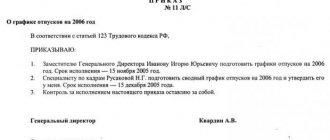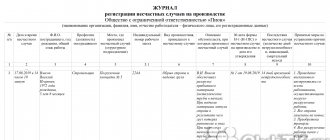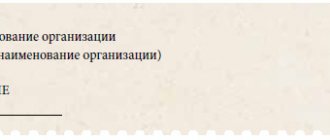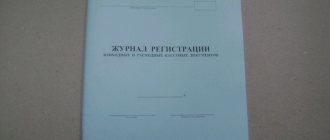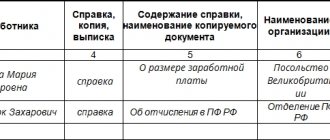Official regulations and functions
On September 6, 2000, a decree of the Federal Archive was issued. So, according to Art. 358 personnel orders must be recorded separately in a special log of personnel orders. Registration of orders can be carried out both in a paper journal and in the 1C program.
The following types of orders are recorded in the journal:
- about hiring
(data is also recorded on whether this is the main job or part-time work, part-time work, rotational work); - on transfer to another position
(orders for increases, changes in wages, and bonuses are recorded); - about dismissal
(this also includes long business trips, maternity leave).
The journal is necessary when resolving labor disputes and analyzing the movement of labor. But its main function is to regulate actions in accordance with labor legislation at the enterprise.
Types of orders for personnel movement
Orders with a shelf life of up to seventy-five years include the following:
- About hiring at the main place, part-time, part-time, on a rotational basis, etc.
- On bonuses for employees for good performance of duties or high performance at work, on the occasion of a professional holiday.
- On the movement of employees (transfer of employees to work in another area, in another department, changes in the salaries of employees, their promotion, etc.).
- On the dismissal of employees, on termination of a contract at the request of the employee or by agreement of the parties, or for other reasons.
- On sending employees on a business trip (foreign, long-term).
- About vacations or business trips related to working conditions that are harmful or dangerous to the health or life of workers.
- On granting employees leave without pay.
- On granting an employee parental leave for up to one and a half, three years.
- On the early departure of an employee from parental leave for up to one and a half, three years.
- On changing the employee's first name, surname, patronymic.
- On encouraging an employee (awarding a certificate of honor, a gift, a bonus, an announcement of gratitude, etc.).
Personnel orders with a shelf life of up to five years can also be classified as a separate group:
- About disciplinary sanctions.
- About short-term business trips.
- About annual paid holidays.
- About holidays, etc.
In any organization, over time, a large volume of documents intended for daily use accumulates. They are contacted in the event of an inspection, audit, or if it is necessary to provide an employee with a certain certificate.
Register of alcohol products in retail: the form and sample of filling out the document are in the article at the link.
To systematize documents and optimize work with them, confirm their availability and quickly search, the organization creates various document logs, including a log of personnel orders.
Sample title page of the logbook for registering orders for personnel.
Design options and requirements
The form of the journal is not legally approved. That is why the leaders of the organization themselves choose how it will be more convenient for them to keep these records.
Often, special paper journals are used for this, which consist of a title page, a page with information about the journal and, directly, fields for recording information. Computer programs, for example, 1C, are used less often. This is due to the fact that electronic documentation is easier to correct than paper documentation.
Despite the fact that there is no single form of registration, a number of requirements are put forward for the document.
- The magazine cover should be hard or semi-hard. Preferably laminated. It indicates the index of the organization and its name.
- The second sheet of the journal indicates the name of the organization, the name of the document and the start and end dates of record keeping.
- The third page contains information about the persons responsible for maintaining the document. In this case, not only the surname and initials of the employee are written down, but also his position, details of the document by which the employee was appointed to this position .
A sample signature of the person responsible for the document is also required. - The document must be numbered to maintain integrity.
- The pages of the magazine must be securely bound and sealed. The number of pages is indicated on the seal. This figure must match the actual data. The information is confirmed by the signature and seal of the head of the enterprise.
- The last sheet contains the end date of maintenance and a note about why and by whom the journal was closed.
You can close a document only after all its pages are completed.
Correct filling and formatting
Regardless of what kind of magazine the enterprise uses (purchased or made independently), it must be designed taking into account a number of requirements:
Availability of hard cover
This is especially true if long-term orders are registered in it. In this case, the use and storage of the document will be long-term, so care must be taken to ensure its safety. The title of the document and its index (if necessary) must also be indicated on the cover.
Completed title page
It should contain the following information:
- Company name;
- start date of logging (can be specified immediately);
- end date of maintenance (set after the document is completed);
- title of the document (same as on the cover);
- journal index;
- information about the person responsible for maintaining the document.
Information from the last paragraph can be indicated either on the front side, or at the end of the magazine, or on each of its pages. It is worth considering that the correct design of the title page is a mandatory requirement for the legality of the document.
Firmware and numbering
All pages must be numbered in a continuous manner, that is, each of them must have a serial number after the title page. After this, the magazine is stitched in accordance with established requirements and finally sealed. Also on the last page there should be the following data:
- total number of sheets;
- signature of the head of the enterprise (or head of the personnel department);
- Stamp of the company.
Additionally, the closing date of the journal and the documentary basis for this must be indicated. The latter is the number of the corresponding order and information about the person responsible for it.
All these requirements are aimed at protecting data from possible corrections.
Since the journal is an important legal document, it must
be issued in accordance with these requirements and filled out correctly. In particular, entries must be entered in full; abbreviations are allowed only if they do not lead to problems in their interpretation.
Also, the document must not contain errors or omissions; the use of corrective tools to correct entries is not permitted. Any mistake made should be crossed out with a thin solid line, next to which the correct entry can be made.
You will find out where to go if maternity benefits are not paid in our material. Are you an employee and want to resign voluntarily, or are you an employer who must dismiss an employee under this scheme? Then our material will be useful to you. If you violated sick leave, you will have to “answer” for it. Read more about the consequences here.
Magazine pages
The main log pages consist of columns and rows in which data is entered.
Let's look at the main columns and give examples for filling out each of them.
- Number of the document being issued. For example: 304
- Document date. For example: 07/20/2016.
- Order number. For example: 489-LS.
- Information about the document, order for admission or transfer, dismissal, vacation. For example: hiring, transfer to senior salesperson.
- Employee data. For example: Ivanov I.I.
If there are two employees in an organization with the same last name and initials, the first and middle names are written in full. - The law or document on the basis of which the order was made. For example: employee statement dated July 15, 2016.
- Signature of the employee to whom the order concerns. Placed after the employee has read the order.
- Information about who compiled the document and entered the data into the journal. For example: Svirodov P.R.
- Signature of a HR employee confirming correctness of completion.
- Additional information. For example: Changing work schedule.
Who should maintain the document?
Any organization that issues local legal acts must have a book of orders. In fact, this means that each legal entity, simultaneously with registration, creates such a document and records there information about the first order - the appointment to the position of general director.
Which employee is responsible for the document and regularly updates the form with information about the latest acts? The answer depends on the size of the organization and the established document flow traditions. Most often, this function is taken on by the manager’s secretary or office manager. If such positions are not included in the staffing table (in small companies), the orders will be registered by the director himself or any of the employees to whom he entrusts this.
Logging
As already noted, the log is kept from the first day of the organization’s operation. It must be filled out by a person appointed by management. This could be a secretary-assistant, an employee of the personnel department.
If the person responsible for the magazine goes on vacation or maternity leave, management is obliged to appoint a new person in charge for the duration of the employee’s absence.
The log is filled out daily. It includes all the personnel changes we listed above.
Let us note that orders for the appointment of officials mentioned in the organization’s charter - the director of the enterprise, the head of a particular department, the head of a branch, etc. - are not noted in the journal. This information relates to orders for the main activity and is recorded in another document.
After the magazine is closed, it is handed over to the archive, where it is stored for 75 years.
Why do you need an order log?
The order journal is not a mandatory document. The need for it arises in enterprises where many internal regulations are issued. It is designed to facilitate the following tasks:
- accounting of published documents;
- execution control - in accordance with the specified responsible persons and deadlines for the implementation of assigned tasks;
- search for an act in the register by number and date of publication.
Organizations create a clerical service responsible for document flow, recording and monitoring the execution of management instructions. The office maintains a register of issued documentation. Copies are sent to structural units for execution, and department employees maintain their own accounting books.
Regulatory material, depending on the assigned tasks, is divided into two groups:
- by main type of activity - relate to the organization of the production process, solving issues of structural units, etc.;
- personnel – relate to labor relations between management and staff.
It is convenient to keep records of administrative documentation in separate books: for documents on core activities and on personnel.
Video: How to create and design a magazine on 1C?
We invite you to watch a video tutorial on creating and designing a magazine in the 1C program. With its help, you can create your own magazine, while independently determining the number of required columns to fill. The information is provided in a simple and accessible form.
All orders that relate to personnel must be recorded in a special journal. Thanks to this, the company’s management, if necessary, will be able to prove its case in labor disputes.
The logbook for registering orders for personnel: a sample of filling out the book is in demand in almost every enterprise. The correct maintenance of this document, which accurately reflects hiring, movement up the career ladder, and dismissal, is not an bureaucratic whim. This document serves as the basis for confirming work experience, and is also one of the fundamental ones for calculating a pension.
Such a journal is created at the very initial stage of the activity of an enterprise (organization). It is carried out throughout the entire existence of the enterprise, regardless of its form of ownership. Early termination of maintaining the Journal by orders of the LS is not permitted. The only reason to start a new journal is to run out of free space for subsequent entries.
Personnel accounting is separated from accounting accounting, which takes into account the main activities on the basis of legal norms. It is impossible to register orders about the personnel of an enterprise together with orders about the main activities, since the first orders concern subjects of law, that is, citizens (regardless of whether these people are citizens of the Russian Federation or foreigners) and they are guaranteed both legal rights and freedom of expression. To put it simply, although at the current stage of economic development, labor power is a commodity that its owner, the worker, produces, cannot in any way be recognized as a commodity. Accounting statements are based on reporting on the formation and movement of goods. Therefore, combining goods and non-goods into one report will inevitably give rise to confusion in the future.
The shelf life of such a journal is at least 75 years. Therefore, certain requirements are imposed on its shape, as well as the quality of the materials from which it is made. It should have a cover made of durable, hard paper; sheets should only be used from high quality paper. The sticker on which the name of the magazine is printed must be well glued and cannot be peeled off.
Why is logging necessary?
Since, in accordance with GOST P 51141-98, registration means a record in the established form of data about a document in compliance with existing rules. Registration confirms the very fact of receipt or creation of a document at a specific time by entering information about it into the appropriate registration form, accompanied by assigning a number, as well as recording basic data about the document.
Thus, it is registration that gives the document legal force, since it is with its help that the very fact of its creation is recorded. Therefore, the order for personnel does not seem to exist before it is registered in the Journal.
The legal basis for the existence of such a journal, the procedure for maintaining it, as well as classifying it as long-term storage documents is the decree of the Federal Archive of September 6, 2000. Article No. 358 of this document establishes the need to keep records of personnel orders separately from other types of document flow. According to the requirements of the regulatory document, a journal (book) for recording orders of personnel appointments, transfers, and dismissals is maintained at each enterprise.
The systematization of the entered information is based on the principle of a chronological catalog. The personnel orders themselves are stored separately, filed in the relevant personal files of employees.
What needs to be recorded in the document?
The journal contains orders that relate to the ordinary personnel of the company. The main such orders include:
- placement, dismissal, transfer;
- maternity leave, layoff, vacation;
- combination;
- business trip;
- changing the employee’s personal data;
- rewarding
Orders concerning company managers are not entered into the journal.
free form for registering orders for personnel.
Orders for main personnel
The journal displays the order for personnel - only those internal documents of the enterprise that serve to determine the official status of hired employees and at the same time serve as the basis for making entries in accounting documents. For example:
- personal cards;
- financial documents;
- work books.
Orders for the appointment of top officials of the enterprise to positions that are indicated in the statutory documents (for example, chief accountant, general director) are considered orders of the main activity and are not displayed in this journal.
A log of personnel orders must be available at every enterprise, regardless of its legal form (firm, company, etc.). It contains information about orders for admission, dismissal, transfer, appointment to a new position, as well as all other orders regarding employees with a retention period of 75 years.
Since the regulations of the Russian Federation provide for the requirements for maintaining personnel records, recording information on internal personnel movements separately from the documentation recording the workflow related to accounting and management activities, the registration of personnel orders is carried out separately. There are no strict legislative rules for the execution of such document flow. The basis for the creation and design of the magazine are the norms that are determined by office practice.
In general, the journal itself, in which information about personnel appointments is recorded, as well as movements in legal regulation, is considered as a document created on the basis of a local regulatory act, that is, its form can be determined by the head of the enterprise independently. However, although there is no standard form, today in office work practice a completely definite form of such a document and the practice of maintaining it have already developed.
This type of log is like a table with several rows and columns:
- column one is used to enter information about the number of the order being fixed;
- the second column is intended to record the date of issue of the order;
- column three is used to enter information about the order number;
- Column four is used to record the type of order - enrollment, internal transfer, dismissal;
- the fifth column contains information about the first name, patronymic, and last name of the employee in respect of whom the order was issued;
- column number six contains the personnel number of the employee in respect of whom the order was issued;
- column number seven contains information about the basis for signing the order, that is, about the employment contract, employee application, additional agreement, and so on, indicating the number, as well as the date of registration;
- Column No. 8 is used to make notes if necessary.
Some clerks add a column for entering information about the summary of the order, which is recorded in the journal.
Logbook for registering orders for personnel
Logbook for registering orders for personnel
- this is a journal in which all issued orders for the personnel of the organization are recorded.
The journal for recording orders for personnel must be laced, numbered and sealed with the signature of the head and the seal of the organization.
The personnel service employee keeping a log of orders for personnel must fill out the columns in accordance with the texts of orders for personnel.
Currently, there is no legally approved unified form for registering orders for personnel, so the organization has the right to develop it independently in any form.
The storage period for the Register of administrative documents for personnel is established by Art. 258 b of the List of standard management archival documents generated in the process of activities of state bodies, local governments and organizations, indicating storage periods (approved by the Ministry of Culture of the Russian Federation on August 25, 2010), and is 75 years and 5 years .
Based on the different storage periods for logs, it can be recommended to have two logs for recording orders for personnel in the organization.
In one journal with a shelf life of 75 years, orders for personnel will be recorded such as:
- about hiring;
- about moving;
- about combination;
- about transfer to another job;
- about dismissal (termination of employment contract);
- on certification, advanced training, assignment of titles (ranks);
- about changing the surname;
- about encouragement, rewarding;
- on wages, bonuses, various payments;
- all types of leave for employees with difficult, harmful and dangerous working conditions;
- about parental leave;
- on leaves without pay (wages);
- on duty according to the profile of the main activity;
- about long-term domestic and foreign business trips;
- on business trips for workers with difficult, harmful and dangerous working conditions.
In another journal with a shelf life of 5 years , orders for personnel such as:
- about disciplinary sanctions;
- on annual paid holidays;
- about leaves in connection with training;
- about duty;
- about short-term domestic and foreign business trips.
A more detailed division of registration of groups of personnel orders and instructions is possible. In this case, independent groups are identified and separate registration files (different journals) are maintained.
Requirements for creating and filling out a journal for registering orders for personnel
Let us note some requirements that you need to know when maintaining a log of orders for personnel. The front side of the journal indicates the start and end dates of its maintenance, the index of this journal according to the nomenclature of cases (if any).
Front side of the logbook for registering orders for personnel
| (name of company) HUMAN RESOURCES DEPARTMENT MAGAZINE REGISTRATION________________________________________ Started |
Information about the employee responsible for maintaining the journal can be provided on the cover of the journal (front or back), on each or the last page:
Person responsible for maintaining the log:
__________________________ __________________________
position last name, first name, patronymic
The pages of the journal must be protected from seizure and attachment, for this:
the sheets of the magazine are numbered, laced, sealed with a seal (waxing wax, mastic) and the magazine is certified by the head of the personnel department or the deputy head of the organization for personnel management or the head of the organization himself;
or
The sheets of the magazine are numbered in order and laced; a sticker with the stamp of the HR department or organization is placed on the lacing node of the sheets on the last page. In this case, a certification inscription is made on the last page:
In this magazine it is numbered, laced
and sealed with ________ sheets
Head of HR Department
______________________ _____________________
(signature) (signature transcript)
“___” ______________20___
Last name, first name, patronymic in journals should be indicated in full, and the name of the position, specialty, profession - in accordance with the staffing table.
Erasures, corrections or deletion of previously made entries using corrective means are not permitted.
If it is nevertheless necessary to make corrections, then erroneously made or incorrect entries are crossed out with one line so that the previously written text is clearly readable. A new entry is made in the same column. If the journal has a “Note” column, the following entry is made in it:
Corrected in column ____
__________________ ______________________
(signature) (signature transcript)
“___” ______________20___
If the “Note” column is missing in the journal, then the erroneously entered information is not crossed out, but under it the same mark is made as in the work book (“entry No. ___ in column No. ___ is invalid”) and new information is indicated.
The journal is an internal document and cannot be transferred to employees of departments other than the HR department without a corresponding order from the head of the HR department.
Familiarization of the heads of departments or other officials of the organization with the journal must be carried out in the presence of the person responsible for its maintenance.
Logs with a certain regularity, established in the personnel department, are presented to the head of the department to check the timeliness and correctness of decisions made, for the preparation of reports, reports, and analysis of personnel work.
During the maintenance process, the journal is kept by the person responsible for its maintenance. When the magazine ends, a corresponding entry is made on the front cover.
Since at present there is no legally approved unified form for the log of orders for personnel, we will give an approximate form of the log. If necessary, you can add additional columns or remove unnecessary ones.
Order number – a digital and/or letter designation (indexation) assigned to a document during its registration.
The rules for indexing personnel orders are developed by the organization itself. In the practice of personnel services, alphanumeric indexing has become most widespread.
If there are large volumes of documents, it is advisable to group personnel orders related to various issues of working with personnel separately, using different indexing. For example: the letter “k” (personnel) or l/s (for personnel) is added to the serial numbers of orders on the movement of personnel (hiring, transfer to another job, dismissal), for orders on the secondment of workers - “km” , on granting vacations - “o”, on incentives - “p”, on disciplinary sanctions - “v”, etc.
The date of issue of the order is the date when it was signed by the manager or authorized person. The date is entered in column 3 (see Appendix).
In column 4 Type of order, a record is made on what issue of work with personnel the order was issued (hiring, dismissal, transfer, about the next vacation, etc.).
Columns 5, 6, 7, 8 contain information about the employee in respect of whom the order was issued.
A summary of the order or its title, which is written at the beginning of the text of the order, is entered in the journal in column 10 (see Appendix).
Column 10 Grounds indicates the initiative document that served as the basis for issuing the order.
What needs to be recorded in the journal
According to the List of standard documentation that is generated during the work of organizations, indicating the time of permanent storage, 2 different periods are established for the storage of journals in which administrative documentation is recorded, which includes orders for the appointment, dismissal and internal job transfer of employees.
It is allowed to enter information about the personal data of employees without writing their full names and patronymics, but using initials instead. If an organization employs two or more employees with the same last names, then their patronymics, as well as first names, are recorded in full.
Certain types of orders regarding personnel are drawn up in accordance with the rules of the document “Unified forms of primary accounting documentation for personnel records.” On January 5, 2004, the State Statistics Committee of Russia issued Resolution No. 1, in which it unified the forms of orders:
- about hiring (Form T-1, as well as Form T-1a)
- about transferring a worker to another job (Form T-5, as well as Form T-5a);
- about termination (termination) of the Employment contract with an employee (or dismissal) (Form T-8, as well as Form T-8a);
- orders for sending a worker on a business trip (Form T-9, as well as Form T-9a);
- orders to encourage employees (Form T-11, as well as Form T-11a).
The letter “a”, which is added to the number that has a unified form, means that it is used to document orders related to personnel, while the order applies to several employees at once (for example, an order to hire several people at once, which form one brigade).
The first is a shelf life of five years (short-term). It records:
- vacations granted for study;
- vacations granted annually in accordance with the provisions of the employment contract;
- disciplinary sanctions;
- duty roster;
- short-term business trips.
The second has a shelf life of 75 years (long-term). It records:
- orders regarding hiring, dismissal, and official transfers;
- information on wages and bonuses;
- information about incentives, awards;
- information on issues of advanced training, certification, assignment of ranks, categories, and so on;
- about duties that are related to the main activity;
- orders for long business trips;
- orders for granting leave without pay.
There is no need to rush to fill out the PM Log. It is worth making sure that the manager does not change his mind about issuing the order, does not change the type of document or its date.
Experienced personnel officers recommend that those orders on personnel that can be attributed to the document flow on the external movement of employees be separated from orders related to the internal movements of employees. This division of data in the future can greatly facilitate obtaining the data needed for analysis:
- general staff turnover;
- frequency and quantitative indicators of employment;
- layoff statistics;
- statistics of transfers, which during the analysis are considered as entering a new job after leaving the old one.
For the same simplification, orders for vacations, for registering sick leave, and orders for business trips can also be taken into account in other journals.
Magazine design rules
There are several requirements for the drug registration journal regarding its design and maintenance.
- The magazine must have a title page. It indicates:
- Name of the organization;
- name of the department (HR department);
- the start date of journaling, as well as the end date (the column is filled in when submitting the document to the archive).
- The responsibility for maintaining the log rests with a specific person. On the reverse side of the title page his name, patronymic, surname, and position are indicated.
- All journal entries are numbered sequentially.
- Orders are entered into the journal in chronological order - the subsequent entry must have a later entry date than the previous one.
When making entries, use standard formats for writing dates - day, month, year.
- Data about the employee (first name, patronymic, last name) in respect of whom the order was issued are entered without abbreviations or changes.
- The information entered into the journal must correspond to the specific content of the orders.
Experienced personnel officers give advice - do not enter all issued orders for employees in one journal, but divide them into groups, basing the division on the type of action regarding the written order. For example, certification, a business trip order, an order to move to a new job, and so on. It is advisable to assign each group its own index. For example, orders for the movement of personnel receive the index LS, orders for vacations receive the index O, records of sick leave receive the index B, orders for business trips are assigned the index KM, and so on. In organizations that employ a large number of employees, such indexing in the future will make it much easier to find the corresponding record. This division also helps in analyzing the work of the enterprise to develop a new form of collective agreement, and analyzing staff turnover.
The Standard Instructions on office work conducted in federal bodies, approved by Order of the Federal Archive (No. 68 of November 27, 2000), do not establish strict rules regarding the numbering order in the Register of Orders relating to personnel. Only the need to number orders in the form of sequential numbering within one calendar year is noted. It is noted that instructions, orders on drugs, on core activities are numbered separately.
Why do you need a magazine?
The legislation does not provide for punishment for the absence of a journal on the main activities of the company, and the main instructions for its preparation are not established. Companies are developing their own magazine format, guided by the Law “On Accounting” dated December 6, 2011. No. 402-FZ.
The journal reflects all orders issued by management regarding personnel . Maintaining such a document makes it possible to track the current order, the chronology of the publication, orientate yourself and quickly find the necessary order. The log records all work activities of employees at the enterprise.
In the event of litigation between the company's management and personnel, the journal will be essential evidence .
Is it necessary to keep such a journal? No, but it is very convenient. However, if you refuse such a document, no one will fine you.
Personnel – all company personnel (permanent and temporary) employed in the company’s labor sphere.
Official labor relations between the organization and the employee arise after the signing of the contractual relationship. After signing the contract on both sides, the employee is automatically enrolled in the staff .
Here you can read in detail about what “staff” and “staffing” are.
Protection of information entered into the log
Journal entries are protected from unauthorized changes in accordance with the requirements for archival documents.
Provides protection from:
- sheet attachments;
- removal of sheets;
- illegal adjustments;
- improper corrections.
Since both the orders themselves regarding personnel and their entries in the legal framework are classified as legally significant documents, in order to avoid mistakes it is not recommended to use abbreviations that may allow the entry to be interpreted ambiguously.
For this purpose:
- lacing the magazine through, including all sheets;
- numbering of all pages;
- the ends of the magazine's firmware cord on the last sheet are fixed with an adhesive sticker with the seal of the organization, as well as the signature of an official, or using a wax seal;
- on the last page before submitting to the archive, a record is made about the number of sheets, this record is certified by the signature of the head of the department, as well as the seal of the organization.
In industrially produced, printed magazines, all these security conditions have already been met, and a sticker with a hologram applied - the inscription “Sealed” - is offered as a seal. When opened, it changes automatically to the inscription “Opened”.
The possibility of the control element peeling off must be completely excluded. It is best to laminate the cover.
From unauthorized corrections, as well as adjustments to records, rules are established for corrections made to journal entries, for example, in cases of entering erroneous information.
For legitimate corrections, the rule for making changes is established in the following order:
- An entry requiring correction is crossed out with a line. Then a new entry is made and a certifying entry is made about the correction made, indicating the date of the action taken with the signature of the person responsible for the correction made;
- any erasures, use of corrective means, or crossing out, as a result of which it becomes impossible to read the corrected entry, is prohibited.
When making changes to the Medicines Journal, changes must be made extremely carefully, in strict accordance with established rules, in clear, easy-to-read handwriting.
Standard form of a book of orders for main activities
Let's look at a sample book of orders for core activities. There is no unified form for such a document; each organization has the right to develop the most convenient option for itself. In any case, the form will be a table with the following data:
- document serial number;
- publication date;
- order number;
- surname of the visa manager, his position;
- summary of the order.
Even novice secretaries do not have problems filling out such a book - everything that needs to be written down is obvious and is on the legal act itself. To clarify any doubts, please study the sample form in the picture above.
Difficulties are often caused by the design of a column with a summary. What to write in this section? Some duplicate the name of the legal act, for example, “On the appointment of a person responsible for fire safety.” This is not a mistake, but it would be much more correct to convey the main content of the order. For example, “On the appointment of chief engineer Petrov S.M. responsible for fire safety." This approach will greatly simplify the search in the register of documents, and if the original is lost, it will help to easily restore it.
When you print and file the magazine, add lines to the last page indicating the number of sheets, as well as the date and signature of the manager. The director must check the book and sign it - only then can the document be sent to the archive.
Download : Journal of registration of orders for main activities (blank form)
Maintaining a log of drug orders in electronic form
Legal and regulatory acts regarding office work and document flow allow for maintaining a medicine journal both in paper, traditional form, and electronically. A computer file, which is essentially a registration table, must be protected from unauthorized edits and, in general, access. The rules for maintaining such an electronic journal are similar to the rules for maintaining a paper journal.
An existing electronic journal, or its separate form, can be printed if necessary, while observing all the necessary requirements for external design:
- cover;
- numbering;
- title page.
The printed sheets are then stapled in accordance with the requirements for page numbering, sheet stitching and stapling, signature certification and sealing.
A journal for registering orders for core activities
is necessary for the company in order to organize effective recording of administrative documents. We will tell you in our article what the specifics of its compilation are and where you can download it.
In what form should records be kept?
The existing document flow procedure for most organizations assumes that the order book will be kept in paper form. This document has a permanent shelf life, so it is logical to have it on physical media. On the other hand, writing the details and contents of the act manually is too labor-intensive and outdated. In addition, readability problems may arise if the secretary writes numbers or letters incomprehensibly.
An electronic journal is much more convenient than a paper one : all the characters are easy to read, some information can be copied rather than rewritten (for example, the name of the manager). However, the registry file must be provided with maximum security so that in the event of a breakdown it does not lose critical data.
It is recommended to store the book in a cloud service (this way the failure of the equipment will not cause damage to the files), as well as print it out and file it annually.
An example of an entry in the journal for registering orders for core activities
Why do you need a journal of orders for core activities?
In such a journal, orders are recorded that establish standards affecting the activities of all or most of the company’s employees - both ordinary specialists and management (general director, deputy directors, chief accountant). This is their difference from orders for personnel, which are much more personalized.
Orders on core activities may regulate:
- business issues;
- planning issues;
- reporting procedure;
- building a sales strategy;
- business expansion tasks.
Typical legal acts recorded in the journal in question, for example, are considered to be orders:
- on the appointment of a director;
- creating a branch;
- introduction of staffing;
- approval of labor regulations;
- ensuring trade secrets.
Thus, the list of orders for core activities may contain both regulatory, mandatory for all employees, and personalized local legal acts (in this case, their effect extends mainly to management representatives holding leading positions in terms of the company’s core activities).
Is it necessary to keep a log of such orders? The legislation of the Russian Federation does not establish such an obligation for private organizations and individual entrepreneurs. But, as the practice of internal corporate document flow in Russian companies shows, the use of a journal helps to increase the efficiency of recording orders for core activities.
Logbook of orders for personnel: practical purpose
The practical purpose of the personnel order journal is to systematize orders issued in a specific organization, which allows you to optimize work with them, including:
- record the date of issue of each order;
- ensure continuity of current order registration numbers, etc.
In addition, a corresponding entry in the order journal, made in accordance with the procedure established by the organization’s local regulations, will help confirm the legality and legal force of a particular document in the event of a dispute.
The organization has the right to independently choose whether to keep a separate logbook for each type of order or to record all orders for personnel in 1 document.
Important! Orders on the appointment of a manager, chief accountant and other persons specified in the company's statutory documents belong to the category of orders on the main activities of a legal entity, and not to orders on personnel (for example, paragraph 1 of Article 40 of the Federal Law “On Limited Liability Companies” dated 02/08/1998 No. 14-FZ).
You can find more complete information on the topic in ConsultantPlus. Full and free access to the system for 2 days.
For information on maintaining a log of orders for core activities, read the article Rules for filling out a log of orders for core activities.
Structure of the order log
The unified form of the journal for registering orders for core activities is not approved by regulatory legal acts and is developed by firms independently. Most often, the journal consists of elements such as:
- title page;
- section indicating the list of employees responsible for maintaining the journal;
- the main section, which serves directly to register orders for the main activity.
The title page of the journal may contain:
- company name;
- Title of the document;
- start date of filling out the journal;
- date of completion of filling out the journal.
In the section on responsible employees the following may be recorded:
- Full name, positions of responsible persons;
- links to documents establishing the powers of responsible persons;
- signatures of responsible persons confirming their keeping of the journal for a certain period of time;
- dates corresponding to the time periods within which the responsible persons keep the log.
In the main section of the journal for registering orders for core activities, the following can be recorded:
- serial numbers of orders;
- dates, numbers, names of orders;
- number of sheets in each order;
- Full names and positions of employees who are subject to a particular order.
Registration requirements
If the employer decides to manually fill out the order log, you need to put a number on each sheet, then stitch all the sheets together. A sticker is affixed to the last page, on which the number of stitched sheets in the document, the employee’s full name, signature and seal are written.
The sticker has the right to be filled out by an authorized person (then his position is indicated) or the manager. The organization's seal must be affixed so that at least a third extends onto the sticker.
The law allows you to start a new journal once a year, but you can do it more often if the old one has run out. The page numbering in the new magazine starts from scratch, the sticker and title page are also filled out from scratch.
The legislation does not establish a uniform form for filling out the journal; the obligation is to develop a document form.
A standard journal should contain the following pages:
- title page;
- several pages listing all executive persons who have the right to make entries in the journal;
- the main section in which orders for main and other types of activities are recorded.
The firm may add other sections, for example, for additional agreements to orders. The title page must reflect:
- full company name;
- document's name;
- time of compilation of the accounting log;
- last day of document maintenance.
On pages about responsible specialists it is allowed to write:
- Full name of authorized citizens;
- links to papers that give employees new powers (for example, an order);
- signatures of the employee confirming responsibility for providing incorrect information;
- dates during which citizens are responsible for the magazine.
The main section is the most extensive; you are allowed to enter the following information:
- serial number of the record;
- document details, date and number;
- the number of sheets that make up the order;
- Full name and position of the specialist in respect of whom the order was issued.
Numbers are written continuously throughout the journal, even if there are no entries on the page. Order numbers are assigned in accordance with the internal regulations of the company. Most often they put an index and a digital number.
In the “Type of order” section, you need to indicate the action that was performed in relation to the person, for example, dismissal, promotion, hiring, collection of a fine, going on maternity leave, etc.
Any entry includes reasons for entering into the journal, for example, an employment contract, a person’s statement, drawing up an additional agreement, a power of attorney, or issuing an employee notification.


